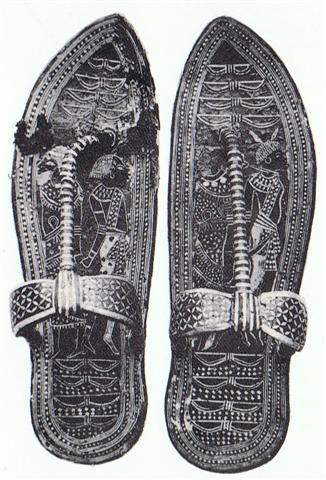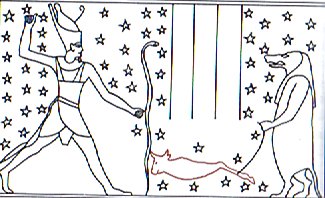3. My suggested connection between Moon and an archer's bow can be further elucidated: According to Wilkinson (Hieroglyfernas Värld) Egyptian pictures often show bows oriented horizontally - a Sign which I have think refers to the passive ('female') state - and usually with its string bound to the central part of the bow (its handle):
Presumably the original reason was to present the bow in a harmless state, but - says Wilkinson - it also allowed the bow to rest from the otherwise constant power from the tight string, which threatened to draw the bow into a skewed form. His explanation does not ring true. From personal experience I know that when a bow is stored away for a while its string has to be unhinged from the bow (not bound to its handle). Furthermore I remember a saying by Pharaoh Amasis that it is necessary to let one's 'bow' rest sometimes or it will loose its resilience. At a solstice Sun is not moving (behaving as if he was bound), a state similar to that of the bow in the T10 hieroglyph. As one of his examples Wilkinson offers the sandals of Pharaoh Tutanchamon:
We need this picture, most of all because it illustrates how in the left sandal 3 strings are used to bind the bows, while in the right sandal 4 strings are needed for each bow. Counting these vertical strings on the right sandal results in 4 * 4 + 4 * 4 = 32, while on the left sandal there are 4 * 3 + 4 * 3 = 24. If we add the great central such signs the results will be: 4 * 4 + 4 + 4 * 4 = 36 respectively 4 * 3 + 3 + 4 * 3 = 27. There are 3 vertical binding strings in the T10 hieroglyph, which probably means it is a 'female' hieroglyph. Possibly this number 3 explains why there is a season Three Saads after Ash Shabt. Beyond Nunki comes the 'Sea' and its horizontal surface could correspond to the state of the 'bound bow':
On the other hand, in the picture below (previously mentioned at Kai Viri, at Parehe, and at Elbow Ornaments) the otherwise difficult to explain central vertical lines could represent the 4 strings necessary to bind the right (active) character at a solstice:
Reading from left to right there is a vertically oriented serpent following the pharaoh figure and preceding the 4 straight (tightly drawn) strings. Beyond this vertical serpent a pair of creatures are looking back and they are connected by a curved string. | ||||||||||||||||||||||||||||||||||||||||||||||||||||


